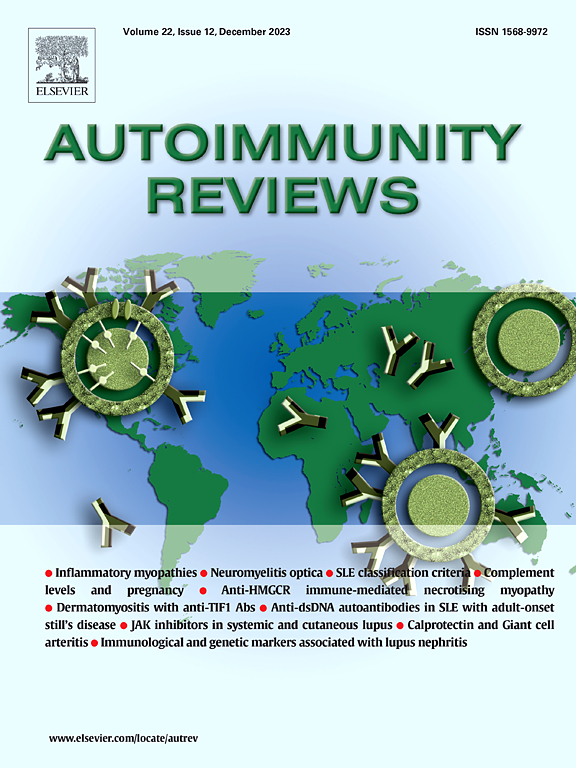系统性红斑狼疮的马赛克:从自身免疫到自身炎症和免疫缺陷,再回到自身免疫。
IF 9.2
1区 医学
Q1 IMMUNOLOGY
引用次数: 0
摘要
麦克格纳格(McGonagle)和麦克德莫特(McDermott)于 2006 年提出了 "免疫学连续体模型 "的概念,重新定义了自身免疫和自身炎症之间的传统二分法,提出了一个先天性免疫和适应性免疫失调可能同时存在的谱系,反映了对免疫性疾病更细致入微的理解。系统性红斑狼疮(SLE)体现了这一连续统一体的复杂性,通常表现为自身免疫、自身炎症和免疫缺陷。遗传、表观遗传、荷尔蒙、心理和环境因素之间的相互作用导致了其独特的免疫病理特征。系统性红斑狼疮历来被认为是一种具有多种临床表现的全身性疾病,它主要是一种多基因自身免疫性疾病,但也可能以单基因形式出现。从免疫学连续体模型的角度来审视系统性红斑狼疮,可以强调先天性免疫和适应性免疫的作用。系统性红斑狼疮和原发性免疫缺陷有相同的遗传易感性和临床表现。此外,自身炎症机制(如炎性体激活和干扰素病)也可在系统性红斑狼疮的发病机制中发挥作用,这说明该疾病处于免疫调节失调的十字路口。认识系统性红斑狼疮及其模拟者的不同临床表现对于准确诊断和靶向治疗至关重要。总之,免疫学连续体模型为理解系统性红斑狼疮提供了一个全面的框架,承认了该病的多面性,并指导着未来的研究和临床实践朝着更有效和个体化的治疗方向发展。在 "自身免疫马赛克 "之后,现在是时候聚焦并尝试解决系统性红斑狼疮错综复杂的马赛克问题了。本文章由计算机程序翻译,如有差异,请以英文原文为准。
The mosaic of systemic lupus erythematosus: From autoimmunity to autoinflammation and immunodeficiency and back
The concept of an “immunological continuum model,” introduced by McGonagle and McDermott in 2006, redefines the traditional dichotomy between autoimmunity and autoinflammation, proposing a spectrum where innate and adaptive immune dysregulation can co-occur, reflecting a more nuanced understanding of immune disorders.
Systemic lupus erythematosus (SLE) exemplifies the complexity of this continuum, often displaying manifestations of autoimmunity, autoinflammation, and immunodeficiency. The interplay between genetic, epigenetic, hormonal, psychological, and environmental factors contributes to its distinctive immunopathological signatures. Historically recognized as a systemic disease with diverse clinical manifestations, SLE is primarily a polygenic autoimmune condition but can, however, present in monogenic forms.
Examining SLE through the lens of the immunological continuum model allows for emphasis on the contributions of both innate and adaptive immunity. SLE and primary immunodeficiencies share genetic susceptibilities and clinical manifestations. Additionally, autoinflammatory mechanisms, such as inflammasome activation and interferonopathies, can play a role in SLE pathogenesis, illustrating the disease's position at the crossroads of immune dysregulation.
Recognizing the diverse clinical expressions of SLE and its mimickers is critical for accurate diagnosis and targeted therapy.
In conclusion, the immunological continuum model provides a comprehensive framework for understanding SLE, acknowledging its multifaceted nature and guiding future research and clinical practice toward more effective and individualized treatments. After the Mosaic of Autoimmunity, it is now the time to focus and attempt to solve the intricate mosaic of SLE.
求助全文
通过发布文献求助,成功后即可免费获取论文全文。
去求助
来源期刊

Autoimmunity reviews
医学-免疫学
CiteScore
24.70
自引率
4.40%
发文量
164
审稿时长
21 days
期刊介绍:
Autoimmunity Reviews is a publication that features up-to-date, structured reviews on various topics in the field of autoimmunity. These reviews are written by renowned experts and include demonstrative illustrations and tables. Each article will have a clear "take-home" message for readers.
The selection of articles is primarily done by the Editors-in-Chief, based on recommendations from the international Editorial Board. The topics covered in the articles span all areas of autoimmunology, aiming to bridge the gap between basic and clinical sciences.
In terms of content, the contributions in basic sciences delve into the pathophysiology and mechanisms of autoimmune disorders, as well as genomics and proteomics. On the other hand, clinical contributions focus on diseases related to autoimmunity, novel therapies, and clinical associations.
Autoimmunity Reviews is internationally recognized, and its articles are indexed and abstracted in prestigious databases such as PubMed/Medline, Science Citation Index Expanded, Biosciences Information Services, and Chemical Abstracts.
 求助内容:
求助内容: 应助结果提醒方式:
应助结果提醒方式:


